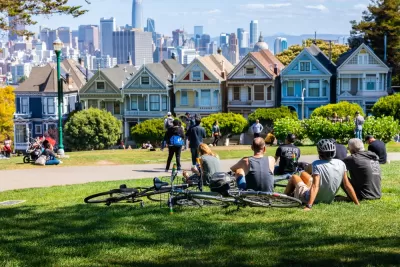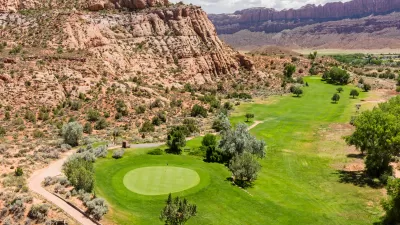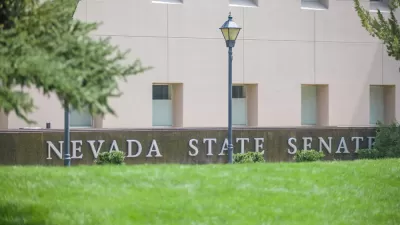Ornamental grass—the kinds of grass that line medians and roadsides but never serves for recreation—is a vanishing amenity in a drought-stricken West.

California legislators approved a bill, AB 1572 (Friedman), to ban the use of drinking water for ornamental grass—also known non-functional turf—grass never used for walking or recreation.
Ian James breaks the news of the approved legislation in. paywalled article for the Los Angeles Times, putting the scale of ornamental grass in perspective for Southern California readers:
Grass covers an estimated 218,000 acres in the Metropolitan Water District of Southern California’s six-county area. Nearly a quarter of that, or up to 51,000 acres, is categorized as “nonfunctional” turf — the sort of grass that fills spaces along roads and sidewalks, in front of businesses, and around parking lots.
Also:
This unused grass covers an area roughly 12 times the size of Griffith Park. By eliminating this grass and replacing it with landscaping that fits Southern California’s arid climate, the district estimates the region could reduce total water use by nearly 10%.
The bill cleared the state legislature with a 28-10 vote by the California State Senate, and now heads to the desk of Gov. Gavin Newsom for a signature.
A few cities and states in the southwest have taken steps to restrict the use of specific water supplies for ornamental and other types of grass, including Las Vegas, Tucson, Castle Rock, Aurora, and the state of Nevada. Many of these new water restrictions only apply to new developments, however.
FULL STORY: California is moving to outlaw watering some grass that’s purely decorative

Study: Maui’s Plan to Convert Vacation Rentals to Long-Term Housing Could Cause Nearly $1 Billion Economic Loss
The plan would reduce visitor accommodation by 25,% resulting in 1,900 jobs lost.

North Texas Transit Leaders Tout Benefits of TOD for Growing Region
At a summit focused on transit-oriented development, policymakers discussed how North Texas’ expanded light rail system can serve as a tool for economic growth.

Why Should We Subsidize Public Transportation?
Many public transit agencies face financial stress due to rising costs, declining fare revenue, and declining subsidies. Transit advocates must provide a strong business case for increasing public transit funding.

How to Make US Trains Faster
Changes to boarding platforms and a switch to electric trains could improve U.S. passenger rail service without the added cost of high-speed rail.

Columbia’s Revitalized ‘Loop’ Is a Hub for Local Entrepreneurs
A focus on small businesses is helping a commercial corridor in Columbia, Missouri thrive.

Invasive Insect Threatens Minnesota’s Ash Forests
The Emerald Ash Borer is a rapidly spreading invasive pest threatening Minnesota’s ash trees, and homeowners are encouraged to plant diverse replacement species, avoid moving ash firewood, and monitor for signs of infestation.
Urban Design for Planners 1: Software Tools
This six-course series explores essential urban design concepts using open source software and equips planners with the tools they need to participate fully in the urban design process.
Planning for Universal Design
Learn the tools for implementing Universal Design in planning regulations.
Ascent Environmental
Borough of Carlisle
Institute for Housing and Urban Development Studies (IHS)
City of Grandview
Harvard GSD Executive Education
Toledo-Lucas County Plan Commissions
Salt Lake City
NYU Wagner Graduate School of Public Service





























